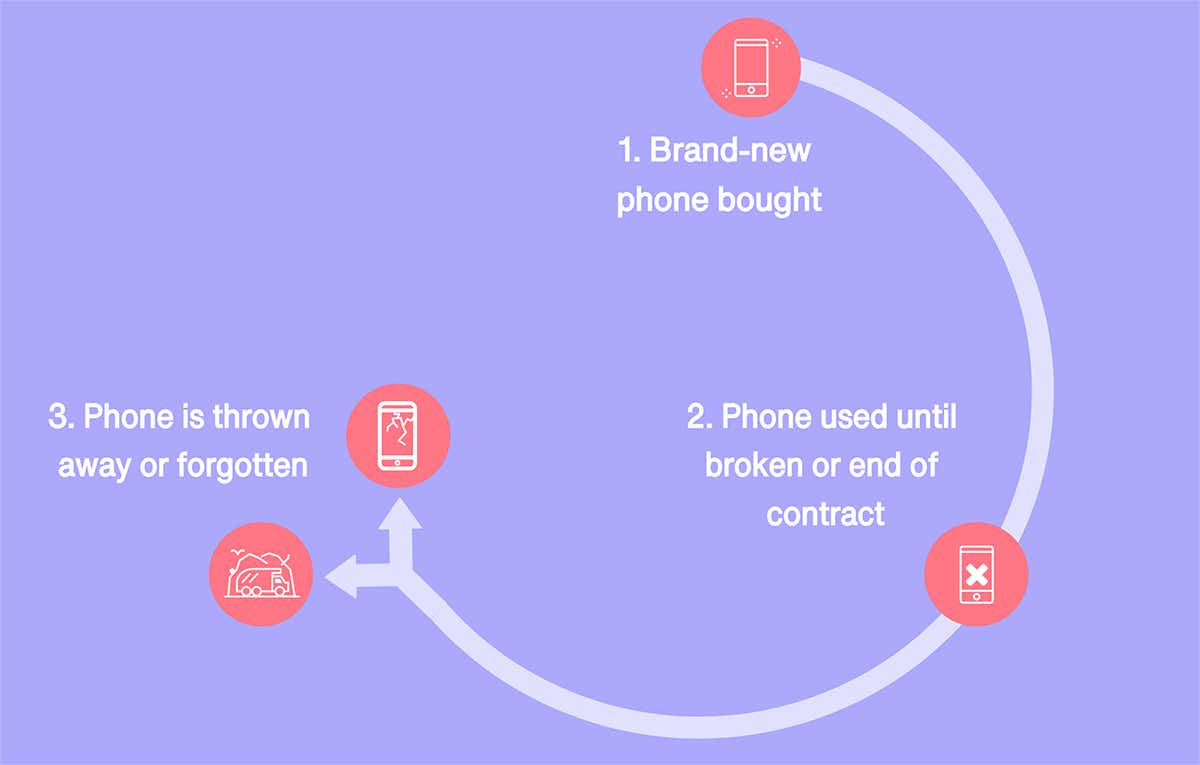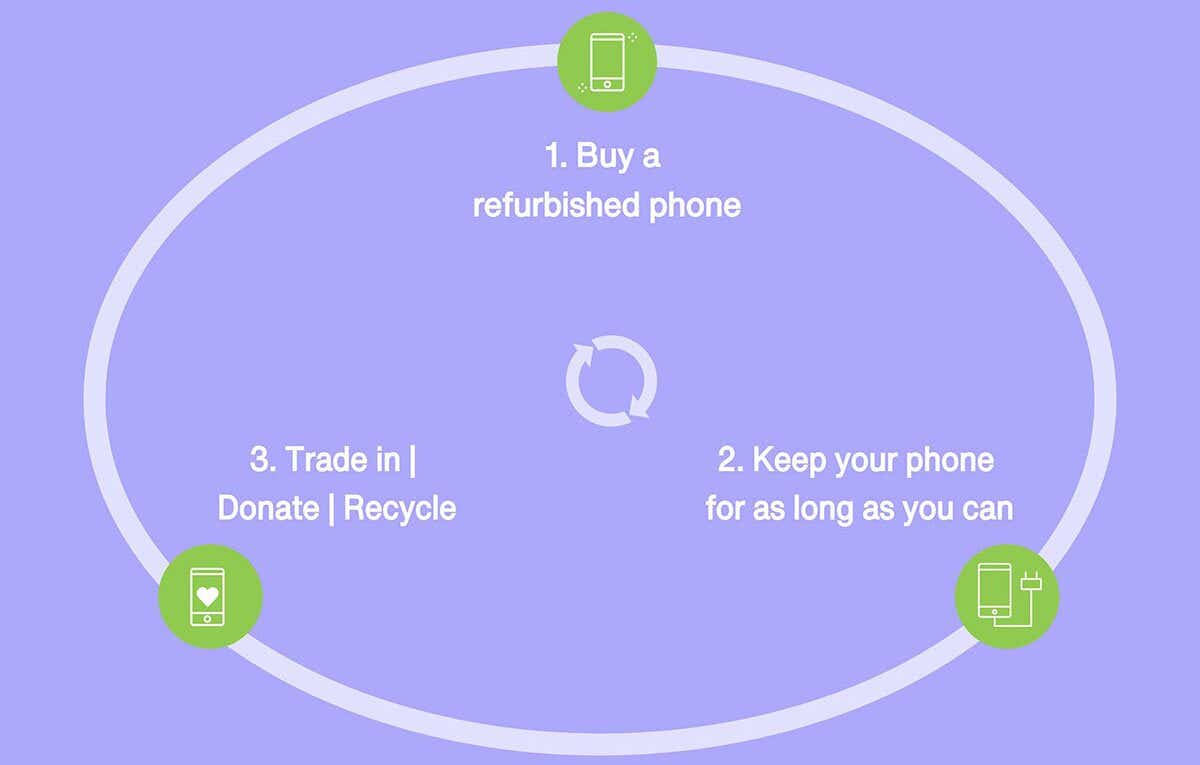Sustainable phones and eco-friendly tech tips
Get our expert advice on how to use your devices in a more environmentally-friendly way.

The life cycle of a phone For the last decade or so, we’ve been replacing our smartphones every couple of years. When the time came to renew our mobile contracts, the latest handset would often be thrown in for a very reasonable price, and many of us would abandon our old device by either throwing it away or leaving it in a drawer somewhere in the house. But there are much better ways to treat your phone, and they can benefit both the environment and your budget.

Unsustainable life cycles
Most phones are bought brand-new.
They're used either until either they break, or the customer's contract finishes.
Then they're often left alone in a drawer or thrown away, and a brand-new phone is bought or replaced.

Sustainable life cycle
A refurbished phone is purchased.
It is kept in good condition for as long as possible, and occasionally repaired when needed.
Eventually, it's either traded in to be re-sold, donated to someone else or recycled to re-use its materials.
Our sustainable phone tips Try one (or all!) of these options when buying your new phone.
Buy a refurbished phone
One of the simplest and most effective ways to reduce your environmental impact.
Prevents perfectly good smartphones going to waste.
Each new smartphone uses finite materials and produces emissions through factory production and transport. The more refurbished phones bought, the fewer brand-new phones need to be made.
Learn more about buying a refurbished phone with our guide.
Keep your phone as long as you can
If your phone still works perfectly fine after your mobile contract ends, keep using it and purchase a cheaper SIMO contract instead.
If your phone is broken, try to get it fixed before buying a new one. Put it in a durable phone case to avoid it getting damaged.
Explore ways to extend your phone’s battery life.
Trade in, donate or recycle
When replacing your smartphone, trade your old one into a retailer. You could make some money from it!
Donate your old phones to a charity that will redistribute them to underprivileged communities.
Even if your phone is nonworking, you can still hand it in to be recycled. It’ll be stripped of its precious materials and reused for future products.
Eco broadband: how to use your broadband more sustainably

Broadband isn’t the first thing to come to mind in regards to sustainability. Some of the benefits it brings, such as cloud storage, fast fibre-optic connections, and the ability to work from home, significantly help to combat climate change.
But the internet is still a very large contributor to greenhouse gas emissions. The amount of energy that servers, networks and computers require is immense. And according to the Sustainable Web Manifesto, if the internet was a country, it’d be the seventh largest global polluter.
Plus, internet connections are still not reliable enough in remote areas, and they’re still too expensive for many underprivileged communities. So we risk many people falling behind as our reliance on broadband increases.
There are lots of ways you can adapt your broadband habits to be kinder to the environment. Browse our tips for using your broadband more sustainably.
Our sustainable broadband tips The internet requires a lot of energy to work. And the more it’s used, the more power is needed to make sure it works for everyone. So we need to make sure we’re using our broadband in the most sustainable way we can. Here’s how you can reduce the environmental impact of your time online, while continuing to use the internet for everything you need and enjoy.
Delete and unsubscribe from things you don’t need
Receiving newsletters or regular emails that you don’t ever look at is a waste of energy. You can reduce the impact of your subscriptions by only signing up for emails that you will read.
Use smaller screens when you can
Devices with smaller screens, such as smartphones, require less power to use and charge than large monitors. So when you can, try to use a smaller device more often. Or if you’re looking to buy a new computer, choose a smaller model.
Stream movies or play games in low quality
If you’re not too concerned about streaming or gaming in full HD or 4K, you could limit the picture quality. It reduces your household’s demand for data and helps your local broadband network run more efficiently.
Download big files at off-peak times
Huge game updates or big programme downloads don’t just put pressure on your own broadband — they can put a strain on the whole network around you. Try to download overnight to ensure your network doesn’t use up more power than it needs to.
How to buy from ethical broadband and mobile networks Many people are changing their buying habits to help reduce carbon emissions from the products they purchase and the companies they use. If you’re looking to choose a broadband or mobile provider that takes sustainability seriously, there are some good telltale signs to look for.
They fix your equipment
They offer to fix your faulty equipment rather than replace it with a brand-new item.
They offer trade-ins
They let you trade in your old devices to either be reused by new customers or recycled for their materials.
They're clear about climate goals
The provider's climate goals are clear and honest (search their name with the terms ‘sustainability’ or ‘environment’).
Minimal, sustainable packaging
They send their products to you in minimal, sustainable packaging that can be easily recycled.
Check back in soon to read our guide on which mobile networks and broadband providers are the most focused on sustainability.
Eco-friendly tech FAQs
What phone is best for the environment?
Buying a refurbished phone is best for the environment, because no new materials have to be used to make it, and much lower emissions are caused by way of production. This way, it’s also easier to stick to a phone brand that you like.
But if you’re looking to buy new, there are a few sustainable phone brands out there that pride themselves on being eco-friendly. The Fairphone, for example, is made of 100% recycled plastics and is almost completely repairable thanks to its modular design.
Is Apple eco-friendly?
Apple is further ahead on sustainability than many of its peers. Some of its largest programmes like Siri, iMessage and iCloud are powered by 100% renewable energy.
Plus, it’s vastly improved the iPhone's longevity in recent years, and made disused ones much more recyclable.
However, as one of the largest companies in the world, it will naturally be producing more emissions than most, just due to the sheer scale of its operations.
What is a digital carbon footprint?
A digital carbon footprint is the total amount of energy you require to use your electrical and internet-connected devices.
All online activities require at least some form of power to work, and big tasks like large file downloads or high-quality streaming will require more energy to facilitate than others.
So if you're looking to reduce your digital carbon footprint, there are ways you can change your online habits to have less of an impact on the environment. Find our eco-friendly broadband tips in our guide.
What is green broadband?
'Green broadband' is broadband that is environmentally-friendly. There’s no official definition for it yet, but it includes things like:
An entire broadband network being powered by renewable energy, so no harmful emissions are caused by people's internet usage
A particular broadband provider uses only electric van fleets, or contributes to carbon offsetting initiatives
Full fibre connections — which could also be seen as more 'green', due to their lack of copper cables and more efficient internet speeds
How sustainable are smartphones?
Smartphones are somewhat sustainable compared to other electronic devices, but they have also caused a significant amount of new emissions.
Over the last 20 years, they’ve replaced countless other products we would have usually bought, such as sat navs, CD players, landlines and even some computers. That’s a lot of emissions saved on the production of unnecessary products.
However, nowadays billions of smartphones are being produced each year. And using and charging smartphones requires a lot more energy than many of the products they replaced. So they have a chance to be much more sustainable than they currently are.
Is the internet bad for the environment?
The internet is great for the environment in many ways. We’ve cut travel pollution by working from home, we’ve massively reduced waste in certain sectors thanks to digitisation, and businesses efficiency has vastly improved across the world.
But it also needs an immense amount of energy in order to work for everyone. Especially to cope with our increasing demand for data and power. So the more often we use the internet, the more emissions that will cause — until the internet can be completely powered by renewable energy, anyway.